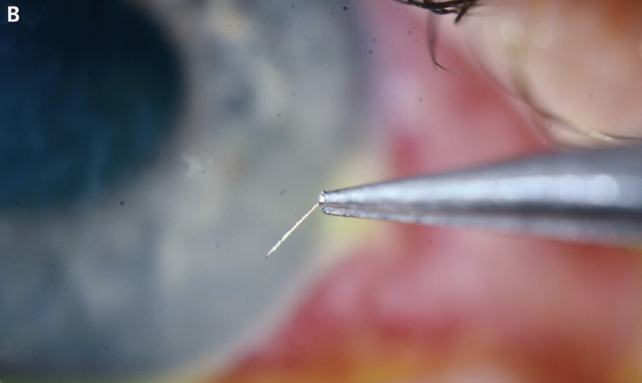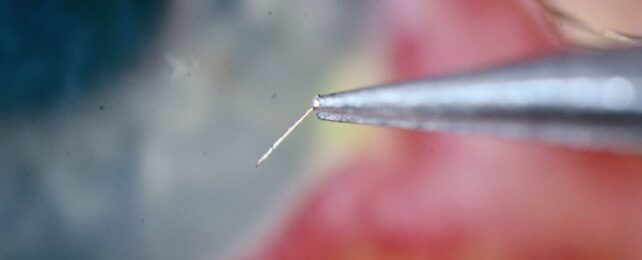Of all the places you can get stung by a bee, the eyeball has to be one of the most unfortunate spots.
A rare case study from Wills Eye Hospital in the US state of Philadelphia details the horrifying story of a 55-year-old man who got a barbed bee stinger stuck in his right eye.
The day of the sting, the man sought help at a local emergency department, who promptly did their best to remediate the problem. Unbeknownst to all involved, the hospital's medical staff were unsuccessful in their attempt to remove all of the offending barb. Much of the spear-like appendage was still left embedded in the patient's iris.

Two days later, the man's vision and pain had worsened dramatically. The vessels in his right iris had begun to bleed, and he could barely see out of his injured eye. All he could manage when he shut his uninjured eye was to count his fingers.
Fearful for his vision, the man took himself to an ophthalmology clinic.
To figure out what was going on, specialists at the clinic used fluorescent dye to stain the inflamed eye's cornea. Under a specialized microscope with a bright light, the team found a tiny, piercing object embedded in the transparent tissue between the iris and the sclera, or white part of the eye.
The thin mucous membrane that covers and lubricates the sclera was inflamed with dilated blood vessels. Meanwhile, the cornea, which covers the pupil and iris, was also swollen.
Photos of the injured eyeball aren't for the squeamish, but for those curious and brave enough, they can be seen here and in the clip below.
Ophthalmologists at the clinic used jeweler's forceps to pull the rest of the tiny foreign object out of the man's eye. The patient was then prescribed eyedrops with antibacterial medicine and steroids.
Five months later, his vision had improved to a little less than perfect 20/25.

"Ocular bee stings warrant referral to an ophthalmologist owing to the severe inflammation that may result from the injury, as well as the possibility of a retained stinger in the eye," warn Wills Eye Hospital ophthalmologists Talia Shoshany and Zeba Syed.
Bee and wasp stings straight to the eye are rare, with only a small number of case studies published in the scientific literature. Without urgent consultation, the damage can be "devastating to ocular health and visual function", experts at the American Academy of Opthalmology say.
The stingers of bees and wasps are barbed, specialists explain, which means they can "saw through" the tissue of the eye. What's more, they also release venom, which can penetrate deep into the gel-like bulk of the eye, exposing the back of the eyeball to toxins and triggering an immune reaction.
In fact, sometimes, if the bee is ripped off its stinger, part of its abdomen can end up in the eye, too.
Removing the stinger can halt the body's immune reaction and improve symptoms, but that may not be necessary or advised in all cases. Roughly 90 percent of the bee's venom is injected in the first 30 seconds of a sting, and if the barbed stinger cannot be easily removed or requires surgery, some ophthalmologists think it should be left where it is for fear of doing more damage.
There are several case studies where stingers remain embedded in the eye and good vision is maintained despite the presence of a foreign object.
In a case study published in the 1970s, for instance, one patient had a bee stinger lodged in their cornea for 28 years without suffering vision issues.
In this recent example, the stinger could thankfully be removed without causing further damage.
The case study was published in The New England Journal of Medicine.
